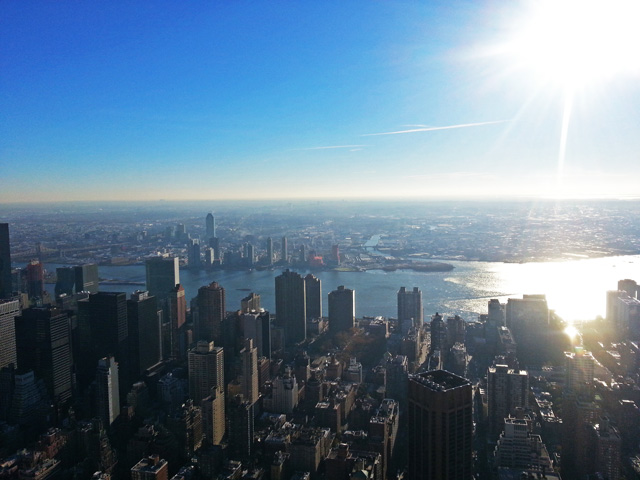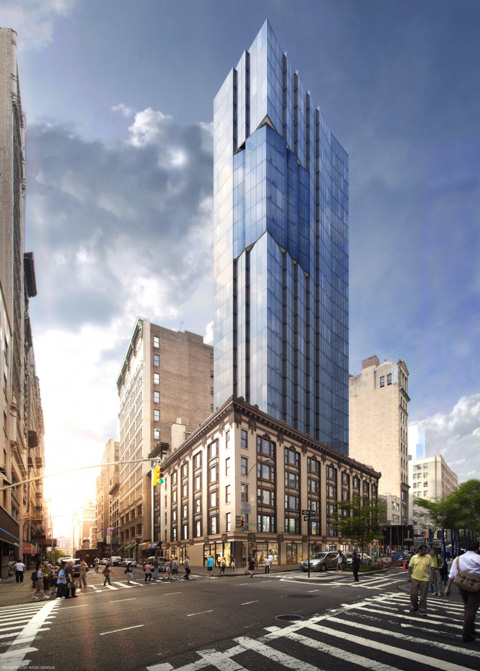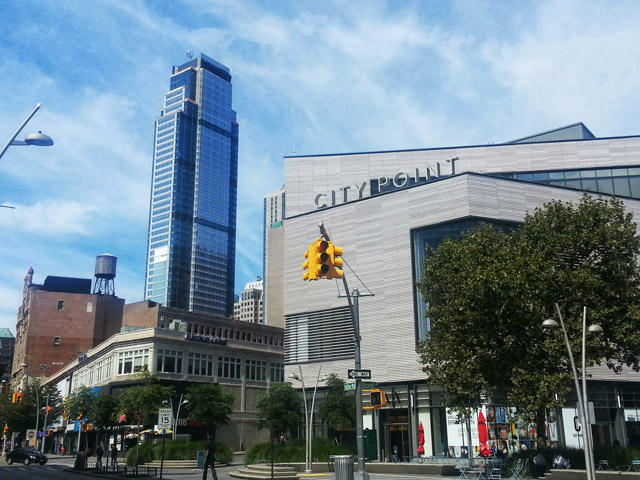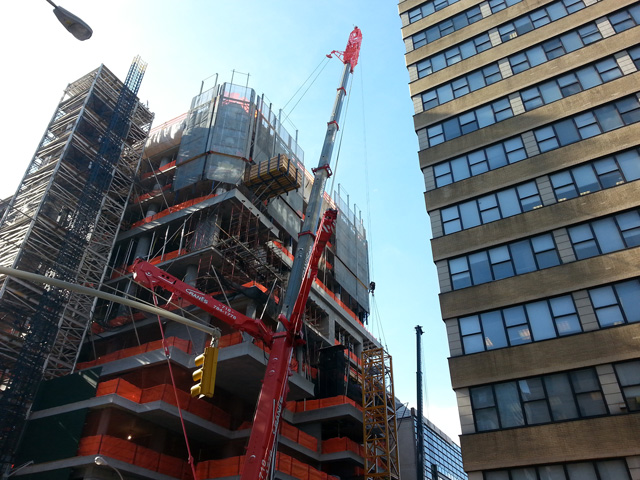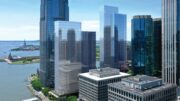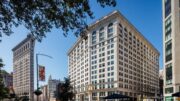YIMBY sat down with Clifford Finn, Executive Vice President of Douglas Elliman’s new development marketing team, to discuss his thoughts regarding what’s up and coming in New York City, the latest happenings in NoMAD, and the continued ramifications of Hurricane Sandy. YIMBY in bold.
Have you heard anything about Journal Square, and do you see it becoming more like Downtown Jersey City or Long Island City? How quickly is it going to develop?
It’s interesting. You know, in the past, Jersey City was more of a suburban mentality; that goes for the people building there, and the audience that was going there. Although many Manhattanites found their way there, a wide audience was filling those buildings; it was a little bit different than crossing the other rivers. But that’s changing, because now everybody is looking there due to the increase in land costs. Brooklyn is not a huge discount to Manhattan anymore, and Long Island City is not far behind it; everybody is looking for the next great, convenient, commutable destination, and they are setting their sights back on Jersey City and the surrounding area.
Moving back to Manhattan, YIMBY attended 1182 Broadway’s opening, which is a converted building in NoMAD; what are some features that make conversions in NoMAD stand apart from new developments in the neighborhood, and what’s special about The Centurian?
In the past, conversions of this type were typically larger buildings that go condo — like 10 Madison Square West. But for rent, you either had the Sixth Avenue high-rises and the few hot buildings off that corridor, or much older conversion stock that doesn’t have the luxury standard of today’s market. And I think what sets The Centurian apart from the rest is that it’s rental, but was built with a condominium sensibility and comparable finishes.
It seems geared towards wealthy bachelors in technology.
Well, some units were; on the typical floor-plates before you get to the upper, larger apartments, we have two loft-style layouts that don’t have a formal bedroom. And then we have two [layouts] that have formal bedrooms, and they’re all similar in size. So I think it’s not just about singles; definitely couples too, and more established people. In that neighborhood, we’re seeing a cross-section of different types of people; it really speaks to a lot of audiences.
And do you think the broad appeal of NoMAD heralds its emergence as one of the most expensive neighborhoods in the city?
I think that it’s one of them, because there’s a lot of similarities between NoMAD and neighborhoods like SoHo and Tribeca — but you have a park, and you’re more centrally located. It’s convenient to Midtown, Uptown, and Downtown, and it’s a great spot if you have to get out of the city quickly because it’s so close to the bridges and tunnels. You’re a little bit more centrally located, but you still have the flavor and feel that you’re not in Midtown.
Where would you say the neighborhood’s boundaries are? Because it’s still emerging.
Madison Square Park ends at 26th Street, so up to about 30th. I think once you cross 30th it gets much more Midtown-like. And then down to 23rd Street; below 23rd people consider it to be Flatiron. And it extends between Broadway and Park Avenue.
Sandy devastated sections of the city; do you see prices being affected in areas like the West Village and the Seaport, if measures to mitigate future events are not taken? If there is another event, do you think the double-whammy could result in a sustained drop in prices?
Not in the immediate future, I mean I myself live in a Zone 1 neighborhood in Lower Manhattan, and it didn’t affect the market for those neighborhoods at all.
But if there was another one?
I think it depends on if they get worse. I think that everybody feels like what happened was very inconvenient, but there was nothing truly devastating. I think the Seaport was much more affected, and that neighborhood is a little more sensitive to future impacts than the West Side. We have a lot of projects that are in flood zones, and plans have remained the same, it’s just that some components have been elevated. And that’s the way things need to be moving forward; you have to build for the tide to go through the property, and not disrupt the tower. We have to build to accommodate; I don’t think people are scared as long as they know that the issues are being addressed.
What about insurance companies?
It’s hard; again, I’m in a Zone 1 building, and our insurance premiums doubled. And that’s unfortunate, but if you have a house on the ocean, it’s a risk you take to be on the ocean. And it’s the same with living in these prime neighborhoods.
As prices in Manhattan rise, Brooklyn and Queens are becoming go-to destinations for luxury real estate. What do you see in the future for Downtown Brooklyn and Long Island City; will the impending development boom keep prices steady, given the amount of supply that will soon be coming online?
No, prices are climbing, and I think they’ll continue to rise. Everything that we’ve been touching has been climbing, and I believe that the bulk of the rental marketplace out there is really what isn’t being built in Manhattan, so it’s not like it’s in addition to anything going up in Manhattan — so there isn’t an abundance of new product. Those price-points won’t exist in brand-new developments on the island, so people have to go to Queens and Brooklyn for these buildings, and I don’t see supply hitting demand — at least in any of the studies we’ve looked at. And the discount, even with future conservative growth, is respectable.
What about Harlem? It seems like people neglect it even though prices there are also increasing.
I think people focus on where the obvious discounts are, and when those go away, they set their sites on the next ones. It’s like Bushwick; is that the next one? No, now it’s Bensonhurst. It keeps moving farther out, and farther up; everything is cyclical. I think people were hot on Harlem a few years ago; people caught on, then the obvious discounts were gone, so the momentum shifted elsewhere. But now everything has elevated, and they are re-visiting Harlem, because what might have not seemed like a discount previously is now well-priced. I think we’re going to see a lot of movement in East Harlem in particular.
But what about all the public housing? Don’t you think that will prevent revitalization?
Yes and no. Anything that’s a destination — a building’s presence will overshadow that. I think people in New York City are accustomed to public housing being all around them. If you look at the West Side, you have the Amsterdam Houses by Lincoln Center; twenty or thirty years ago, you would never walk around back there. But now, it is completely surrounded on all four sides with extremely expensive luxury housing, and neighborhoods that didn’t exist back then. I think people are accepting, and if it’s a neighborhood on the verge, people are likely to take the discount. You don’t have to twist anybody’s arm to buy near the Amsterdam Houses today.
So, finally: If you could pick the top three neighborhoods to invest in today, which would they be?
I think one of the best — and I’m not just saying this because we have a building going up there — but I think Inwood is one of the very few sleeper neighborhoods still around, and I really like it. I still think, for different reasons, that FiDi is still comparatively undervalued. You’re starting to see the trickle-down effect from the Village and SoHo, as it heads Downtown. With North FiDi, especially; all those buildings on the border of Tribeca.
Like 56 Leonard?
Yes, 56 Leonard, 101 Leonard; they’re on Broadway, or Worth, or Leonard. They’re at the cross-roads of entering the Financial District, and we’re seeing those numbers shoot up. And as we see businesses populating the World Trade Center — plus the Fulton Center and the new malls — basically they’re going through the process of building an infrastructure that never existed Downtown, so that it can compete with other residential neighborhoods. It always catered to the business community, and I think the FiDi has been around for long enough as a residential destination that we’re just now seeing the makings of a true residential area in terms of amenities. So I like it for those reasons; it still has a lot of room to grow.
It would be difficult to pinpoint a neighborhood in Brooklyn, but I love Gowanus; I think it’s like a case-study.
Have you been there?
Yes, we’re working on projects there. The thing about Gowanus is that it’s the epicenter of many other neighborhoods. It’s between Carroll Gardens and Park Slope, which are two fabulous neighborhoods.
Isn’t it centered on a toxic canal?
For many years the canal was toxic and polluted, and not very attractive —
So it’s basically like Greenpoint-lite.
Yes, but that’s changing; it’s being cleaned-up and redeveloped. There is a population of young artists and creative types that have been living in that area, and it’s been one of those sleeper neighborhoods for a long time. And as pricing continues to escalate in adjacent established neighborhoods, Gowanus is on the verge of major change.
And why has it remained so undervalued; the pollution?
Well because it had a very old stigma attached to it because of the canal, so people stayed away. But at this point we’re out of land, and it’s there, and it is a very good location — and the pollution is being addressed, and re-mediation has been ongoing for years, though it has not been obvious to people. But it’s really on the way. And Whole Foods is opening a Gowanus location, and I think that says a lot.
For any questions, comments, or feedback, email newyorkyimby@gmail.com
Subscribe to YIMBY’s daily e-mail
Follow YIMBYgram for real-time photo updates
Like YIMBY on Facebook
Follow YIMBY’s Twitter for the latest in YIMBYnews

